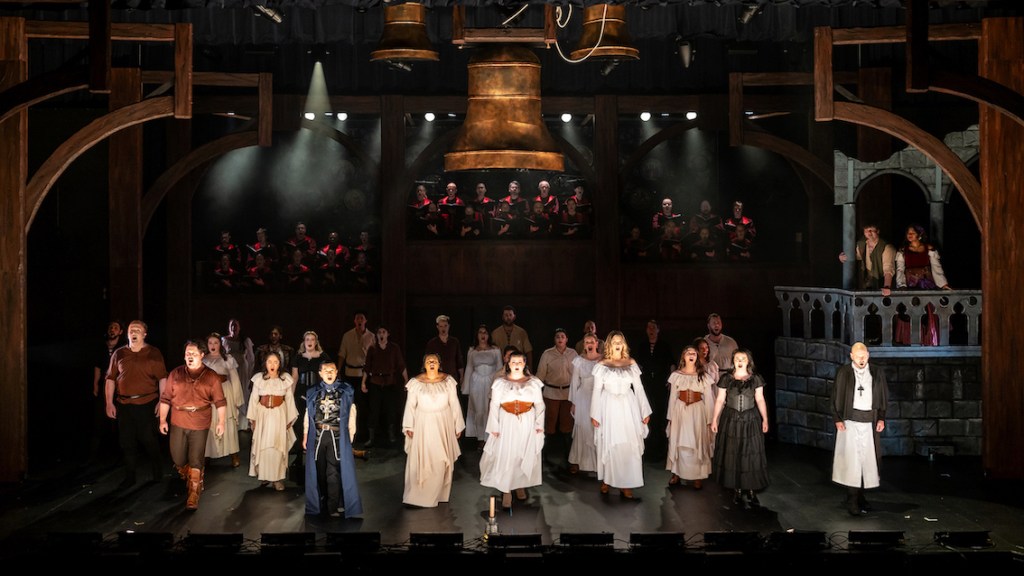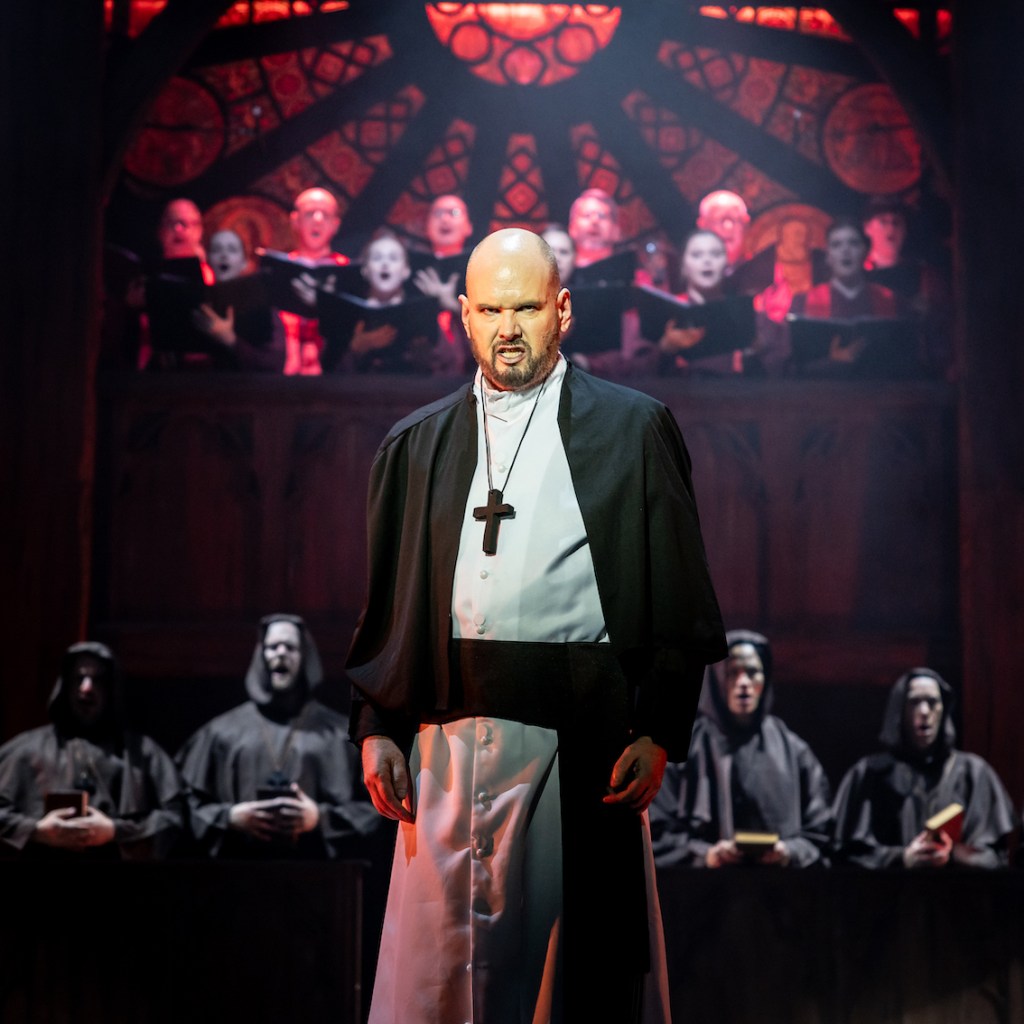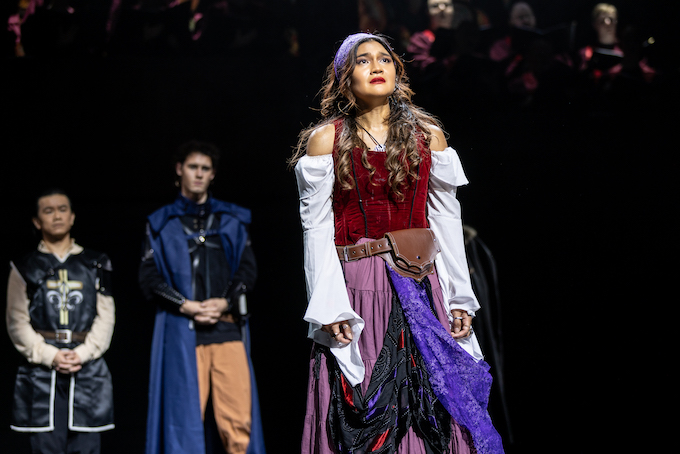A rare dark Disney musical, The Hunchback of Notre Dame sweetens a tragic tale with a beautiful Alan Menken score, which is all the more glorious when the 32-member choir takes flight.
The stage musical version seen in this very welcome Victorian premiere season is the second adaptation deriving from the 1996 Disney movie The Hunchback of Notre Dame, which rode in on the wave of extraordinarily successful animated movie musicals in the 1990s. Menken was joined by Broadway composer Stephen Schwartz as lyricist, and the pair has added further songs for the stage.
Original German production Der Glöckner von Notre Dame (1999), with a book by James Lapine, was a smash hit in Berlin but then went unseen for several years. A new English-language version in 2014 saw the book rewritten by Peter Parnell and further new songs penned by Menken and Schwartz. (The US season of this production was reviewed by Man in Chair in 2016).
The current incarnation of the musical decisively excises the Disneyfied happy ending and even cuts out the comic relief of Quasimodo’s trio of gargoyle pals. Parnell’s book returns to Victor Hugo’s original novel for inspiration and yet features its own complex story, particularly the backstory of how Quasimodo came to be under the guardianship of tortured and torturous cleric Frollo.
Focussing on one musical production per year, OSMaD is able to expend considerable effort on their works and the result for The Hunchback of Notre Dame is a particularly grand staging. The set design of Brenton van Vliet centres upon a sturdy rotating construct of Quasimodo’s tower, with a view of Paris and three majestic bells overhead. One of Notre Dame’s iconic rose windows appears behind the choir for ground level cathedral scenes.
Just slightly pre-dating Hamilton, the costume design for The Hunchback of Notre Dame calls for the stage performers to begin in neutral tones before “taking on” the costumes of the characters. Significantly, this means that the audience sees the actor playing Quasimodo put on the hunch and disfiguring make up, making it clear that this is a deliberate stage choice and not any sort of appropriation or mockery.
The lush choir of 32 singers backs a further 30 players on stage for a whopping total of 62 performers, which would just not be possible in a professional production. Music directors David Barrell and Ned Dixon have prepared the singers to a meticulously high standard such that the beauty of the massed singing is a standout attraction of the season. Further musical splendour is heard from the orchestra of 14 musicians, conducted with absolute confidence by Barrell.
Sound design by Marcello Lo Ricco and Steve Cooke is, as ever, crystal clear and impeccably balanced. The score calls for numerous solo lines from the stage ensemble as part of the narration and as comments from Quasimodo’s statue “friends.” Whilst these lines are always clearly heard, the atmospheric lighting design of Peter Verhagen often makes it very hard to distinguish who is singing, especially among the statues and gargoyles. Singers who are able to naturally draw attention to their contributions fare best with these solo lines.
Director Joel Batalha impressively brings the complex story to rich life, not shying from the moral quandaries of the lead characters. In the evening’s most powerful scene, Batalha use stillness and silence to provide a palpable sense of weight to the impact of the attempted sexual assault of Esmeralda by Frollo. Although accent work could have used a clearer focus, the world of Parisians and Roma (referred to as Gypsies in the text) is well established.
Working with a cast primarily consisting of singing actors, choreographer Caitlin Lamont delivers lively ensemble scenes, with highlights being “Topsy Turvy” and “Tavern Song.”
Taken to the audience’s hearts as Quasimodo, Matthew Tomlin skilfully meets the physical and vocal challenges of the role while also delivering the emotional heart of the trusting and suffering character. After the extended prologue, Tomlin brings the show into focus with Quasimodo’s I Wish song “Out There,” later singing “Heaven’s Light” with tender sweetness.
In a powerhouse performance, Zak Brown makes Frollo a uniquely three dimensional villain, always carrying the character’s backstory and deftly balancing Frollo’s care for Quasimodo with his insidious use of psychological control. Brown’s richly burnished baritone is heard at its best, particularly in the anguished prayer “Hellfire.”
Ninna Aguirre brings a real humanity to Esmerelda, convincingly portraying the vivacious young woman as a person of authentic compassion. An expressive singer, Aguirre particularly delights in act two balls “Someday,” which was heard on the closing credits of the 1996 movie.
A dashing and appealing leading man, Tom Liszukiewicz deftly offsets the lightly humorous vanity of military Captain Phoebus with the haunted aspect of his frontline trauma. Although not given a full solo number of his own, Liszukiewicz nonetheless impresses with a charming tenor voice as heard in numerous featured sequences.
Pasquale Bartalotta makes for a lively and engaging Clopin, leading company numbers with charismatic confidence.
The stage ensemble performers keep energy high, also very capably assisting with the movement of large scale sets. Cameo roles are strongly cast, greatly aiding the ongoing storytelling. The rear choir is spotlighted in the act two entr’acte, deservedly earning hearty applause from the opening night audience.
A serious and pensive musical, The Hunchback of Notre Dame will reward lovers of the movie as well as audience members who prefer weighty musical drama over the more prevalent light and frothy offerings.
The Hunchback of Notre Dame plays at Geoffrey McComas Theatre, Scotch College, Melbourne until 16 December 2023. For tickets, click here.
Photos: Ben Fon
Categories: Music Theatre, Reviews








We went to the matinee yesterday.
The show was delayed by nearly an hour due to technical difficulties which were visible throughout the first act.
These things happen of course but unfortunately we had to leave during intermission to be able to travel back home.
We came from Geelong via vline.
The actor’s that played quasi and clopin were great.
Sorry to hear that you did not have the chance to see the full show, John. Some wonderful music in act one though.
Hopefully the difficulties have been sorted for the remainder of the season.
Hi John. Can you please message the Ticket Secretary OSMaD please at Steve.cavell@osmad.com.au